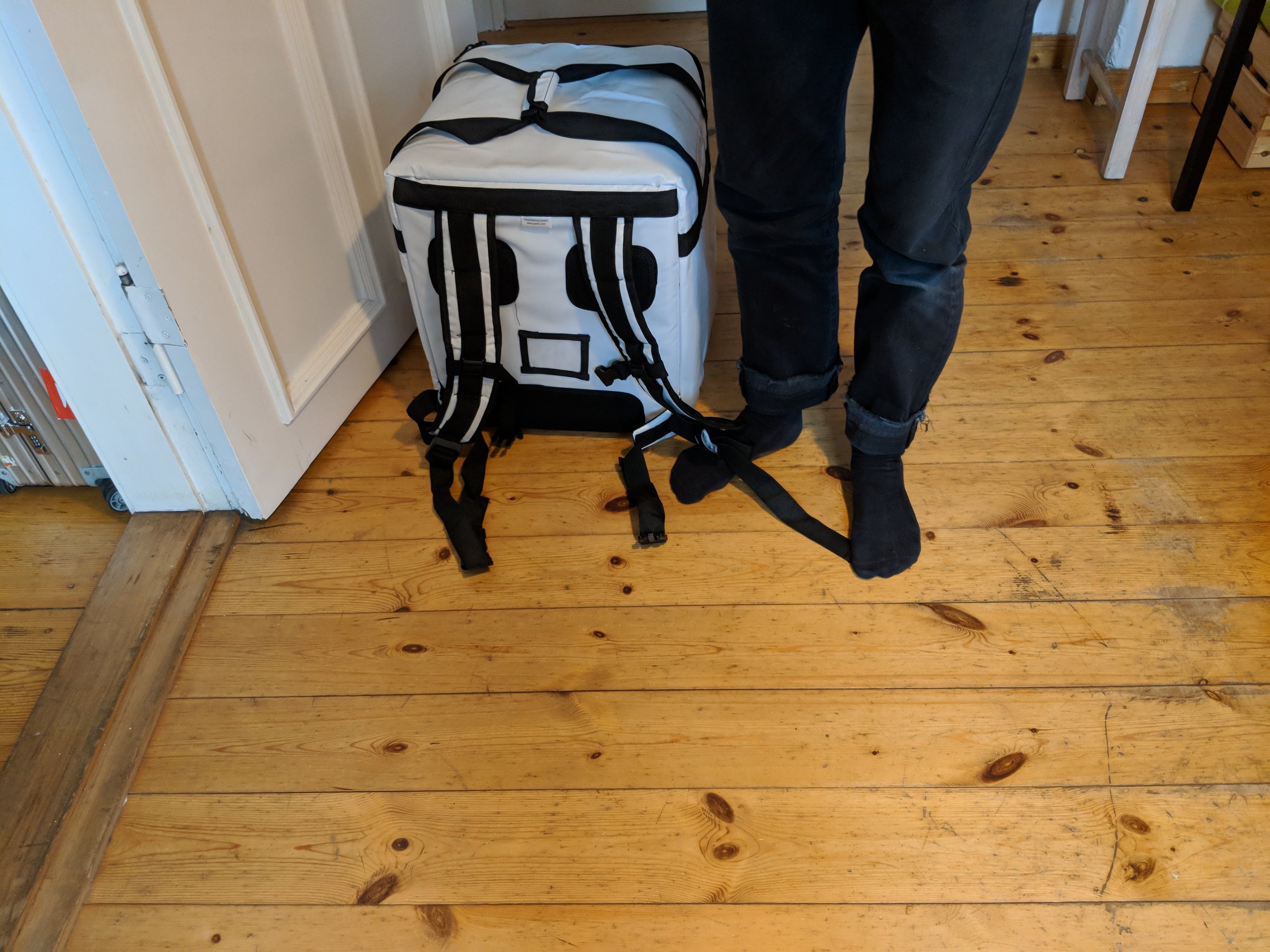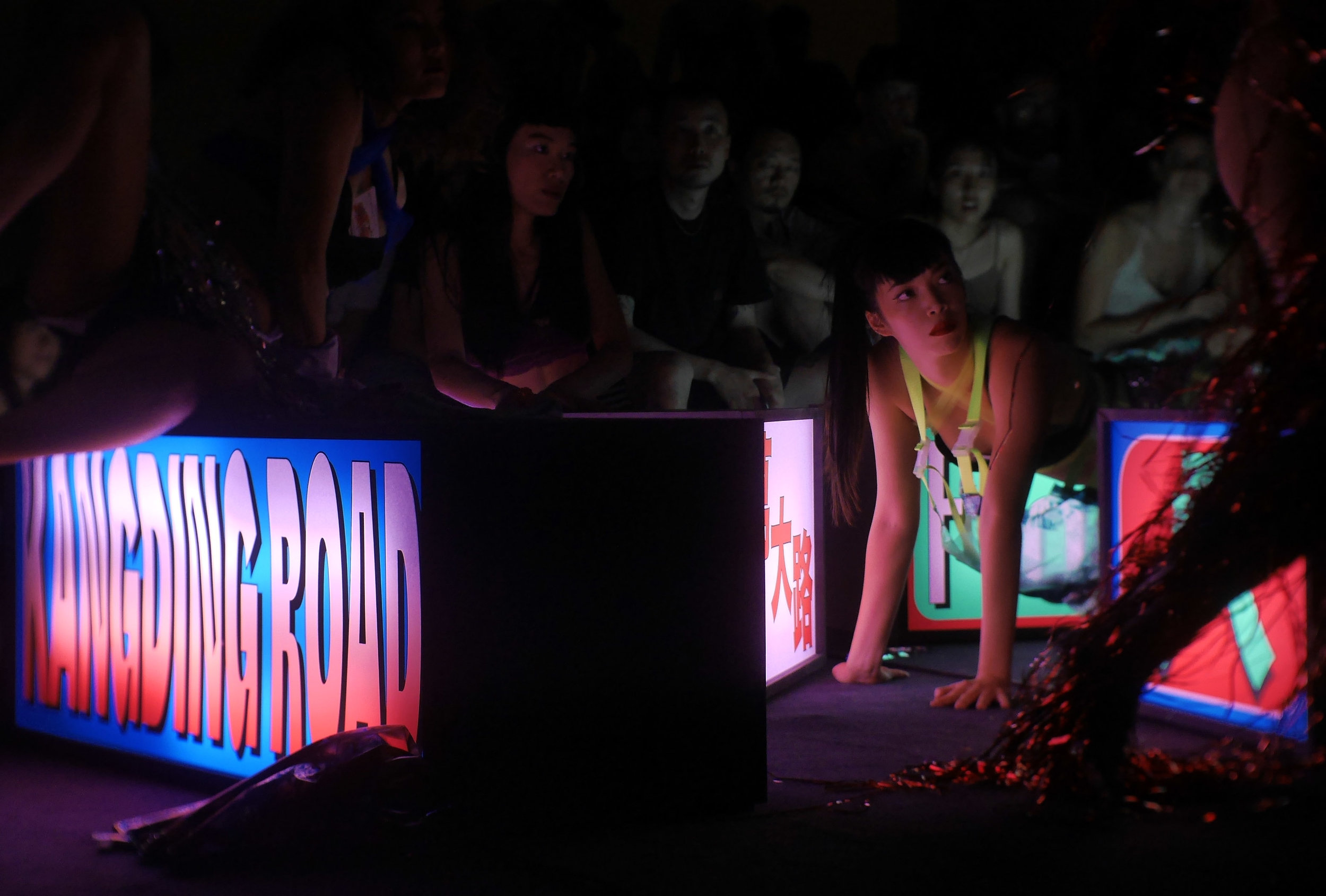Gallery Delivery 📦

Gallery Delivery. A group exhibition by Sebastian Schmieg, Presented by Roehrs & Boetsch Gallery.
“Gallery.Delivery is both a group exhibition and a performance that can be ordered online. It will be delivered by bike courier in a "White Cube" courier bag to the address stipulated in the order, where it will be temporarily installed.”
The global pandemic has heavily affected the art world. Many museums shut down and the art market is declining. Large galleries took to online viewing rooms in order to sell or show art, while smaller galleries are slowly going out of business. “The art gallery system is built on 19th-century handshakes,” says Evan Beard, national art services executive at Bank of America Private Bank. “It wasn’t built for a digital environment, which has caused a vicious innovation cycle. Some of that will ultimately lower the cost of business. But in the near term, it’s a stopgap. We talk to say they will be down 70 percent.” (Wall Street Journal). Although this project was not built for tackling the global pandemic, It is interesting to consider this medium between analog and digital - a happy in between.
The Berlin art week can get tiring and time-consuming. Berlin is a vibrant city, which is developing at a rapid pace and turning into quite a unique spot for many artists. With a growing number of artists living, working, and exhibiting in Berlin, each art week has even more to offer and is spread out even further. Running around and going out for dinners is fun, but in certain moments, nothing beats a delivery. Gallery delivery offers a delivery service for an exhibition.
After two successful Berlin art week shows, gallery delivery is now offering this service in Milan.
How it works is quite simple. You go to gallery.delivery website, you choose a time and date that suits you, enter a delivery address, pay 15 euros, and place your order.
I always hosted a brunch on the first weekend of the Berlin art week. It is a great way to exchange ideas, narrow down the agenda, and catch up with friends, as everyone seems to be in town during this period of time. In 2018, for the first time, we had a new guest arriving at the annual art week brunch,- The Gallery Delivery courier. He buzzed in, punctually, I waved at him through my window, seeing him pass through the courtyard, carrying a large white cube. Upon arrival, he greeted everyone politely, placed the white cube on the floor, and started fishing around in it, looking for different art pieces, then, handing them out, or looking around for a suitable spot to place them.
People started chatting, asking for more information about the artists, passing small sculptural, multi-media pieces around amongst themselves, and taking loads of pictures and videos. Looking at art in art galleries is a completely different way of approaching art than in this format. It’s interesting how much the element of tactility brings people together. Being able to touch the art, rotating it in their hand, or placing it at different heights, enables the observers of the art to be curators of this exhibition to an extent. In some cases, the correct placement was more important than others. For example, the work of Elisa Giardina Papa, BRUSH STROKE N.006, 2019, an aluminum sculpture, was the most interesting precisely because of the specific point of view, in which it should be installed.
Image source: Sebastian Schmieg, Galler.Delivery. Elisa Gardina Papa - BRUSH STROKE N.006, 2019.
Brush Stroke is a flat, minimalist sculpture printed with a white and grey grid on its front side. When seen and photographed from a specific point of view, it is perceived as a deleting brush stroke that erases the space in which it is installed.
Gallery.Delivery, obviously does not encompass all of the responsibility of curating, but rather just the fun aspects of it. Not a single one of my guests was disengaged, and while we were already being quite loud for a Sunday in Germany, the noise level only went up as more audio-visual work was being introduced, and more discussions started. Some people decided to make purchases, and others jotted down some artists on their notes.
The exhibition also came with a booklet and a price list, as all of the works were available for purchase then and there, as well as, in case of hesitation, later through their website.
Interview with Sebastian Schmeig, the creator of the project.
Sebstian Schmeig is a Berlin-based multi-media artist and the creator of Gallery.Delivery project. He works in a wide range of media and focuses his practice on finding the hidden realities of our networked contemporary society. Sebastian took some time out of his busy schedule to talk to Farrago Letter about the global pandemic, art, and the concept of exhibition delivery.
How did you come up with the Gallery.Delivery concept and what it's all about?
Gallery.Delivery is an exhibition format and a performance that can be ordered online. You order the group exhibition through a website and it will then be delivered by a bike courier to your apartment. Contrary to how delivery services usually work, the courier enters your apartment where he temporarily sets up the exhibition. About an hour later, after you have looked at all the works and maybe bought one of your two, the courier packs up everything again and leaves.
As part of my practice, I research networked labor and the gig economy, among other things. Like others, I was quite fascinated by the oversized cube-shaped delivery bags that highlight the algorithmically managed bodies which have to fulfill the promise of immediate availability and delivery.
My idea was then to transfer this setup into the context of the arts, but in such a way that the courier becomes an integral part of the whole exhibition and performance. Together with the gallery Roehrs & Boetsch I could realize the concept for the first time in Berlin in 2018.
What do you like the most about this concept?
I really appreciate its unpredictability and that the exhibition somehow manages to enter into people's private spaces, allowing the courier, various people, and several artworks to come together. Each exhibition is different, depending on how the courier interacts with the apartment and with the people who have ordered the show.
I also enjoy the opportunity to curate a show, working together with other artists.
When Gallery.Delivery is actually happening, the most fun part for me is hearing the courier's stories at the end of the day.
Do you have a favorite Gallery.Delivery so far? Tell us about it.
The first edition in Berlin was special as we had no idea what would happen and if it would work out, but I also really enjoyed the second edition as we didn't have to start from scratch. This allowed me to invest more time and experience into curation.
Pandemic has strongly affected the art world. With the major art fairs being indefinitely postponed, and some of the largest auctions being canceled, where does Gallery.Delivery stand?
We had to cancel one edition in Mulhouse, France and had to postpone one edition in Zurich. However, two new editions are in the pipeline. The concept seems to fit very well in our current situations, but at the same time, the challenge is to adapt it in such a way that it can be conducted safely.
Q5: What's the biggest limitation you had to overcome when you first came up with the concept, before bringing it into being?
As nobody had any prior experience with running such an exhibition format, there were a lot of uncertainties. Will people order? How long should the courier stay? What kind of artwork will work well? How can the buying process be done in a simple way? The goal was to make it look as easy and effortless as possible while at the same time being quite a complicated production, from promotional photos to the fully automated ordering process and an algorithm that manages logistics.
In the end, I realized a lot of it came down to the personality and the commitment of the courier himself, which luckily worked out very well here in Berlin.
Q6: Do you see Gallery.Delivery format as the future of how art can develop?
I think once it is possible again, people will want to go out as much as possible. However, the corona situation aside, Gallery.Delivery addresses two things that will be relevant in the future, too: Gallery.Delivery seems to solve the problem that gallery space is expensive, shifting those costs to who orders and hosts the show. And secondly, the format focuses on creating an experience that also allows people to share that experience through social media, involving those who cannot be present.
But actually, I hope in the future there will be enough affordable room for artists, project spaces, and galleries. Making labor relationships visible instead of hiding them behind gallery walls and layers of white paint is also something that hopefully continues to develop.
Q7: You have successfully expanded Gallery.Delivery from Bering to Milan. What do you see as the next steps?
For Gallery.Delivery to be feasible under the current conditions, it will need to be safe while still creating a moment of encounter and intimacy.
Gallery.Delivery purchases:
Jaakko Pallasvuo
Avocado ibuprofen Prescription vial, 2019 plastic phenol-free thermal paper.
Jaakko took his addicting digital instagram page under the same name @avocado_Ibuprofen offline for Gallery Delivery. They were for sale five euros a pop, and of course, I had to purchase one myself.
“make comics that are mainly about pain. I hope that reading them will make the reader's pain subside for a moment.” - Jaakko Pallasvuo
Purchase from Gallery.Delivery 2018.
FORGOT YOUR PASSWORD? (BERLIN 123 MOUSEPAD EDITION), 2018 BY ARAM BARTHOLL.
Until next year. Go to Gallery Delivery's official website to find out, when and where the new convenience will reemerge next.

















